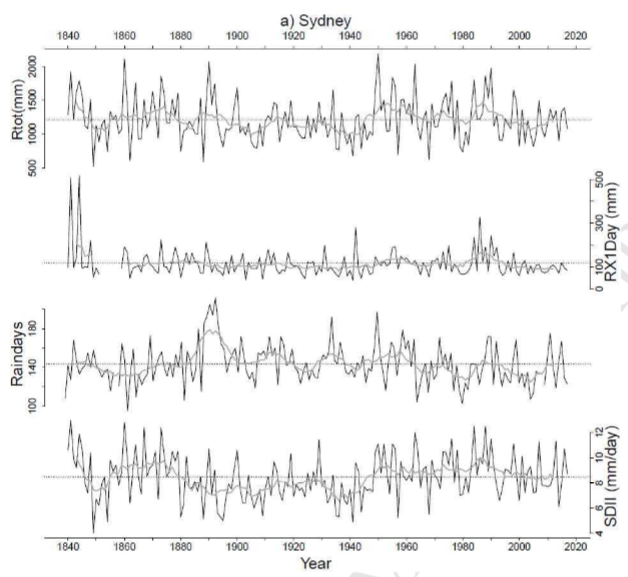Well, maybe we aren’t all going to die in 11 1/2 years, like some surrounding Australia’s Labour Party were insisting before the recent elections.
Hat-tip: reader Mary Brown
A new study appearing in the Journal of Weather and Climate Extremes titled “Historical extreme rainfall events in southeastern Australia” – led by Linden Ashcroft, School of Earth Sciences, University of Melbourne – shows that even more extreme weather in terms of rainfall existed before 1900 in Melbourne, Sydney and Adelaide.
No real trend when examining Sydney, Australia data going back 178 years. Image: Ashcroft et al 2019.
Moreover, the authors found a “moderate and relatively stable relationship between El Niño–Southern Oscillation (ENSO) and annual variations of total rainfall and the number of raindays.”
What follows is the paper’s abstract (my emphasis):
Abstract
The cities of Melbourne, Sydney and Adelaide are home to almost half of the Australian population, and are often exposed to extreme rainfall events and high year-to-year rainfall variability. However the majority of studies into rainfall in these cities, and southeastern Australia in general, are limited to the 20th century due to data availability. In this study we use rainfall data from a range of sources to examine four rainfall indices for Melbourne, Sydney and Adelaide for 1839–2017. We derive the total rainfall, number of raindays, wettest day of the month and the simple daily intensity index for each city over the past 178 years, and find relatively consistent relationships between all indices despite potential data quality issues associated with the historical data. We identify several extreme daily rainfall events in the pre-1900 period in Sydney and Melbourne that warrant further examination as they appear to be more extreme than anything in the modern record. We find a moderate and relatively stable relationship between El Niño–Southern Oscillation (ENSO) and annual variations of total rainfall and the number of raindays at all three cities over the research period, but no relationship between ENSO and the annual wettest day, in agreement with other studies using shorter time series.”
Note how the authors mention how “extreme daily rainfall events in the pre-1900 period” in Sydney and Melbourne “appear to be more extreme than anything in the modern record.”
So despite the constant claims of worsening weather globally, objective analyses of longer term data consistently show that weather in terms of hurricanes, tornadoes, extreme precipitation, etc. were just as bad or even worse in the preindustrial times. It’s natural, stupid.
All the pagan-minded rain-dancing, socialism and wealth destruction and redistribution isn’t going to change our weather.






This looks like half a day’s work after obtaining the data. The general link between ENSO and rainfall in eastern Australia is already very well known.
Here I was thinking that when the Sun shines it draws moisture from the ground, rivers and oceans and said moisture rises and can form clouds and if you are lucky rain falls from some of those clouds and hopefully dumps it where it is needed or can be collected/dammed and or even fill rivers and lakes.
[…] Read more at No Tricks Zone […]
I think you have missed the major issue John. The pattern and extent of rainfall over the whole period of 178 years shows today as being nothing out of the ordinary. Currently we are experiencing a major drought but it’s not the first time and probably won’t be the last. It’s called climate variability
The rainfall data from the BoM a reasonably reliable because they are not easily manipulated.
As the BoM page indicates annual rainfall for SE Australia is very variable from year to year but the overall linear trend from 1900 is dead flat:
http://www.bom.gov.au/climate/change/#tabs=Tracker&tracker=timeseries&tQ=graph%3Drain%26area%3Dseaus%26season%3D0112%26ave_yr%3DT
Nevertheless that doesn’t stop the monomaniacs of the media claiming every flood and extended dry period as incontrovertible proof of ‘climate change’ and that’s true, but there is absolutely no evidence of any human influence.
[…] P. Gosselin, May 21, 2019 in […]
Greenis are crying and looking for new legends.
May 23, 2019 More BBC Drivel On Catastrophic Sea Level Rise
Today’s climate rubbish from the BBC (analysis after the jump):
Scientists believe that global sea levels could rise far more than predicted, due to accelerating melting in Greenland and Antarctica.
The long-held view has been that the world’s seas would rise by a maximum of just under a metre by 2100.
https://principia-scientific.org/more-bbc-drivel-on-catastrophic-sea-level-rise/